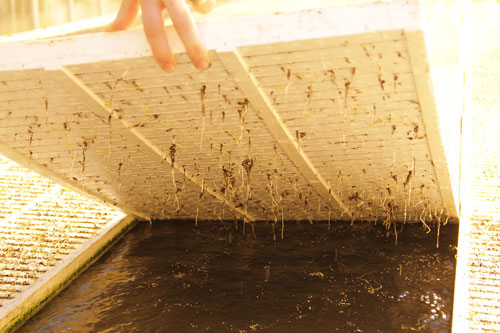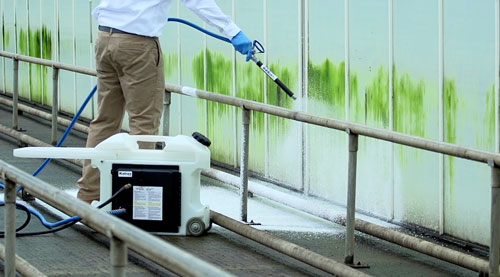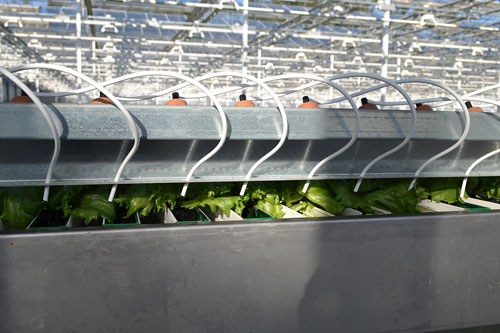8/1/2022
What’s in Your Water?
Jennifer Polanz
Start clean and stay clean. It’s a simple motto, easy to remember and words to live by, according to Eric Smith. He’s the national sales manager, horticulture division, for BioSafe Systems and has traveled extensively, visiting controlled environment agriculture growers to help them keep their irrigation systems clean.
Because of the nutrient mixes used in hydroponic growing, the water is ripe for a variety of pathogens without proper care. We’re going to explore the “baddies” and the “goodies,” and what you can do to start clean and stay clean.
A life of its own
There’s potential for a lot of life happening in your water, both good and bad. Dr. Paul Fisher, a professor of Environmental Horticulture and Extension Specialist at the University of Florida, has dedicated a lot of his research toward water quality. He lists four groups of microbes that are potentially in irrigation water at any given time: algae and biofilm, water-borne plant pathogens like Pythium, food safety pathogens like E.coli and Salmonella, and beneficial microbes.
Those beneficial microbes are important to your crop, too. Examples include Tricoderma harzianum, Bacillus subtilis and Streptomyces. Paul says these can be inoculated into the plug trays before they’re transplanted into the hydroponic solutions.
“These are the microbes you’re trying to encourage in the root environment. If you have a completely sterile environment, it’s easier for plant pathogens to come in and invade root systems,” Paul adds. “One of the key things to my mind, one of our next frontiers when it comes to hydroponics, is to have a more sophisticated idea of creating a really healthy root zone system, and also have a beneficial microbe community to oppress diseases.”
 Pictured: A standard operating procedure for sanitizing surfaces should include time to completely sanitize rafts used in deep water culture systems.
Pictured: A standard operating procedure for sanitizing surfaces should include time to completely sanitize rafts used in deep water culture systems.
So how do you know what’s in your water? Testing is essential to understand first what you’re dealing with.
“We provide tests twice a year—we have a warm-season and a cool-season baseline, so we can see the window of pathogen opportunity where things might be fairly calm,” Eric notes. “Even with municipal sources, they’re going to see different bacterial issues from the summer to the winter.”
And Eric adds, if you’re on municipal water, you’re not immune to pathogens in your water. They test for food-safety pathogens, but not plant pathogens.
What’s most common?
Algae and biofilms often build up in hydroponic systems, even if you can’t see them yet. They are two different things, though often lumped together. They both can clog the system, harbor pests and pathogens, and impact the health of the crop. But biofilm clings to the surface of irrigation pipes and components of the recirculating system with a slimy layer where Phytophthora, Pythium and algae spores can grow. Thanks to Paul’s research, biofilm can be identified early through water samples to ensure it doesn’t take hold.
“Food crop growers certainly have to care about those things,” Eric says. “When left unchecked it does often harbor pathogens, algae and other issues.”
When it comes to water-borne pathogens, Pythium is typically the culprit since it flourishes in nutrient-rich systems and the spores survive in the water as a water mold, Eric says.
“Some folks might see it with experience, noticing it as brown roots, diminishing vigor and yield,” he adds. “And usually, because it is so ubiquitous in these types of systems, it is Pythium.”
It’s important to identify and treat right away (we’ll get into treatment next) because of the nature of the recirculating system.
“If you get Pythium in one part of the crop, it’s going to spread to the rest of the crop,” Eric emphasizes.
The treatment plan
Let’s go back to the beginning: start clean and stay clean. One thing Eric says he’d like to see more of is a standard operating procedure that includes a clean-out schedule for all surfaces that touch the water. That includes a line shock, or irrigation sanitation, that strips out any biofilm and algae from the system at once. It also includes sanitizing any rafts or NFT gutters, and any other surfaces that come into contact with irrigation water.
“Water treatment can only take you so far,” he says. “It’s a big piece of the puzzle, but you have an equally big piece in hard surface sanitation.”
 Pictured: BioSafe Systems offers a foaming agent that can be used with SaniDate 5.0 to clean hard surfaces—including higher-up, hard-to-reach surfaces in indoor vertical farming—to kill algae, biofilms and pathogens without the need for rinsing after.
Pictured: BioSafe Systems offers a foaming agent that can be used with SaniDate 5.0 to clean hard surfaces—including higher-up, hard-to-reach surfaces in indoor vertical farming—to kill algae, biofilms and pathogens without the need for rinsing after.
OK, next to the water. There are a range of treatments that can be effective in different parts of the cycle. Paul points out non-chemical treatments like UV radiation, heat, filtration and reverse osmosis, and chemical treatments like ozone and hydrogen peroxide. They all have pros and cons, he says, but the overarching goal is to make sure the treatment meets the needs of the operation.
“What we don’t want to do is have residual chemicals in the circulating nutrient solution because the roots are very sensitive to those,” he says, advocating for a point treatment. “They will treat the water at one point in the system without having carryover phytotoxicity to the plant. They are short-lived and break down into water and oxygen.
“Sometimes what will happen as the water circulates through the system, you can add in a water treatment somewhere in that loop, trying to have enough dose to kill the bad guys. We really want to still encourage a good microbial community and healthy roots. You don’t want to solve one problem and cause another.”
He adds his goal when he works with growers as a consultant on water quality is to minimize the risks of pathogens coming in.
“A very important point is that when you think of analysis for critical control points, think of all the ways pathogens, whether E.coli or Pythium, can come into the system,” Paul says. “Water is only one of them. Think of workforce with spores that are coming in on clothing or tools, or even spores coming in through the air. You could have a wonderful expensive water treatment system, but that only addressed one potential source of a pathogen coming in.”
Eric agrees and says additional measures like footbaths at the entrance to the growing area, as well as monitoring outdoor areas like retention ponds and even the dust from a gravel parking lot, can go a long way to keeping a clean environment.
He adds there are three ways to address pathogens in production: spray the crop, treat the water and hard-surface disinfection.
“Let’s use the example of an NFT leafy green system,” Eric explains. “If you’re not going to spray the crops to prevent pathogen issues because of marketing reasons, then you are leaving yourself the other two options. These two types of applications are that much more important to make sure you have a clean crop, and a marketable one, for that matter.”
Eric also notes that human pathogens like E.coli and Salmonella are easier to kill from a chemical perspective than plant pathogens and require lower rates of application. His company offers products like ZeroTol and SaniDate that are EPA registered to kill Pythium that also kill human pathogens and break down into water and oxygen. The SaniDate 5.0 also can be used for hard-surface sanitizing, and now it’s available with a foaming agent to make it easier to spray and disinfect large areas without having to rinse them.
Start clean, stay clean
The keys to retaining a quality water system and clean facility are to identify where pathogens can enter, test water to determine mitigation efforts and create a standard operating plan for keeping surfaces and irrigation lines clean. When writing the SOP, explore areas of potential cross-contamination to ensure those areas get cleaned frequently, as well.
“Growers build an entire calendar of production, growth and harvest without taking time to consider clean-out needs,” Eric says. “As a food safety need, and regulatory issue for inspections, it’s something growers really need to build into their SOPs because of the time it takes to clean out those facilities and those structures.”
 Pictured: Biofilms can clog irrigation lines, including lines like these used in NFT systems, and can harbor pathogens. It’s important to create a treatment plan to eliminate biofilms and pathogens.
Pictured: Biofilms can clog irrigation lines, including lines like these used in NFT systems, and can harbor pathogens. It’s important to create a treatment plan to eliminate biofilms and pathogens.
Paul agrees, noting growers should work with a consultant to find the best strategy for their operation, as they aren’t a one-size-fits-all.
“A key take-home message is water treatment is only one aspect of risk management for food and plant pathogens. It requires a systems approach to identify critical control points,” said Paul. “Another piece is choosing the technology that’s going to be well-targeted to control the risks or contaminants without creating some of the problems, such as plant damage/phytotoxicity.”
A Rundown of Water Treatment Options
Four university researchers (Rosa Raudales, Jennifer Parke, Charles Guy and Paul Fisher) wrote a paper analyzing the efficacy of a variety of water-treatment options for horticulture growers. These are excerpts of their descriptions of some of the treatments and how they work. Scan the QR code to purchase the full report.
Filtration: The mechanisms of particle removal with filtration consist of straining, impaction, interception, adhesion and flocculation. Filters suitable for removal of microorganisms from water are either membrane filters with small pore size or slow sand filters. Particle filters with larger pore sizes and rapid sand filters are important to reduce clogging of membrane filters by particles, to remove soil and plant material that may contain pathogens, and to reduce chemical sanitizing demand of the irrigation water.
Heat Treatment: High temperatures disrupt cell integrity and interrupt metabolic processes in sensitive microorganisms. Heat treatment is applied by passing water through a series of heat exchangers until the target temperature is reached. After the required contact time is provided, heat is recovered and the irrigation solution is cooled before application to the crop.
Hydrogen Peroxide: Hydrogen peroxide (H2O2) can be used directly as an oxidizing water treatment. Hydrogen peroxide is also an active ingredient in the class of “activated peroxygen” products where H2O2 is combined with organic acids such as acetic acid to form more stable and effective sanitizing molecules, including peroxyacetic acid.
Ozone: Ozone (O3) acts by direct oxidation or through the production of short-lived hydroxyl free radicals and superoxide ions. Ozone is an unstable gas which must be generated onsite, usually via corona discharge or ultraviolet radiation. Briefly, the corona discharge method passes high voltage through two separated electrodes causing the release of electrons to the gap between electrodes. The energy from the electrons dissociates the oxygen from the environment resulting in ozone formation from the combination of oxygen atoms (O−) with oxygen molecules (O2).
UV Treatment: Ultraviolet (UV) radiation results in a photochemical reaction that damages DNA and RNA molecules, inhibiting their replication and translation in cells. UV radiation is often combined with other sanitizing options, such as ozone or activated peroxygens, leading to increased pathogen control.
More Water Resources
CleanWater3.org
Paul Fisher manages this website that offers resources for water management.
IndoorAgCenter.org
The Center of Excellence for Indoor Agriculture offers services, including water analytics and management, as well as links to research.
e-gro.org
This website for E-Gro Alert has resources on a wide variety of topics, often including water quality and management.